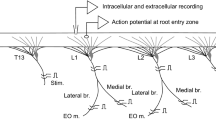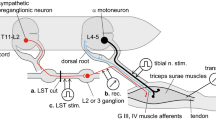Abstract
Experiments on anesthetized cats with partial transection of the spinal cord showed that reticulo-spinal fibers in the ventral part of the lateral funiculus participate in the inhibition of polysynaptic reflexes evoked by stimulation of the ipsi- and contralateral reticular formation. The reticulo-fugal wave in the ventrolateral funiculus evoked comparatively short (up to 70 msec) IPSPs in some motoneurons of the internal intercostal nerve investigated and at the same time evoked prolonged (up to 500 msec) inhibition of IPSPs caused by activation of high-threshold segmental afferents. This wave also led to the appearance of IPSPs in 14 of 91 (15.5 %) thoracic spinal interneurons studied. The duration of these IPSPs did not exceed 100 msec; meanwhile, segment excitatory responses of 21 of 43 interneurons remained partly suppressed for 120–500 msec. It is concluded that the inhibitory action of the lateral reticulo-spinal system on segmental reflexes is due to several synaptic mechanisms, some of them unconnected with hyperpolarization of spinal neurons. The possible types of mechanisms of this inhibition are discussed.
Similar content being viewed by others
Literature cited
R. Anastasievich, D. A. Vasilenko, A. L. Kostyukov, and N. N. Preobrazhenskii, "Reticulofugal influences on interneurons in the lateral region of gray matter of the cat spinal cord," Neirofiziologiya,5, 525 (1973).
I. S. Bezhenaru, A. P. Gokin, A. G. Zadorozhnyi, and N. N. Preobrazhenskii, "Synaptic activation of thoracic spinal interneurons by reticulospinal pathways," Neirofiziologiya,4, 566 (1972).
A. P. Gokin and A. G. Cheslavskaya, "Monosynaptic excitation of thoracic spinal motoneurons by reticulospinal fibers of the lateral funiculus," Neirofiziologiya,9, 630 (1977).
A. P. Gokin, A. I. Pilyavskii, and I. Pavlasek, "Synaptic activation of thoracic spinal interneurons by reticulo-spinal fibers of the lateral funiculus," Neirofiziologiya,10, 150 (1978).
P. G. Kostyuk, Structure and Function of Descending Systems of the Spinal Cord [in Russian], Nauka, Leningrad (1973).
P. G. Kostyuk and N. N. Preobrazhenskii, "Patterns of inhibition of polysynaptic reflex responses during stimulation of the medullary reticular formation," Fiziol. Zh. SSSR,53, 1048 (1967).
P.G. Kostyuk and N.N. Preobrazhenskii, Mechanisms of Integration of Visceral and Somatic Afferent Signals [in Russian], Nauka, Leningrad (1975), 223 pp.
N. N. Preobrazhenskii, I.S. Bezhenaru, and A. P. Gokin, "Monosynaptic excitatory postsynaptic potentials in thoracic motoneurons under reticulospinal influences," Neirofiziologiya,1, 243 (1969).
A. I. Shapovalov, Neurons and Synapses of Supraspinal Motor Systems [in Russian], Nauka, Leningrad (1975), 228 pp.
D. Carpenter, J. Engberg, and A. Lundberg, "Primary afferent depolarization evoked from the brain stem and the cerebellum," Arch. Ital. Biol.,104, 73 (1966).
S. H. H. Chang and C. D. Barnes, "A presynaptic mechanism evoked from brain stem reticular formation in the lumbar cord and its temporal significance," Brain Res.,45, 101 (1972).
J. Engberg, A. Lundberg, and R. W. Ryall, "Reticulospinal inhibition of transmission in reflex pathways," J. Physiol. (London),194, 201 (1968).
J. Engberg, A. Lundberg, and R. W. Ryall, "Reticulospinal inhibition in interneurones," J. Physiol. (London),194, 225 (1968).
A. P. Gokin, J. Pavlasek, and P. Duda, "Neuronal mechanisms of spino-bulbo-spinal activity," Neuroscience,2, 297 (1977).
E. Jankovska, S. Lund, A. Lundberg, and O. Pompeiano, "Inhibitory effects evoked through ventral reticulospinal pathways," Arch. Ital. Biol.106, 124 (1968).
A. Lundberg, "Control of spinal mechanisms form the brain," The Nervous System, Vol. 1, The Basic Neurosciences, Raven Press, New York (1975).
S. Lund, A. Lundberg, and L. Vyklicky, "Inhibitory action from the flexor reflex efferents on transmission to Ia afferents," Acta Physiol. Scand.,64, 345 (1965).
R. Nyberg-Hansen, "Functional organization of descending supraspinal fiber systems to the spinal cord. Anatomical observations and physiological correlations," Ergebn. Anat. Entwick. Gesch.,39, No. 2, 1 (1966).
O. Pompeiano, "Reticular formation," in: Handbook of Sensory Physiology. Vol. II. Somatosensory System, Springer, Berlin (1975), pp. 382–488.
M. Shimamura and R. B. Livingston, "Longitudinal conduction system serving spinal and brain-stem coordination," J. Neurophysiol.,26, 258 (1963).
A. Torvik and A. Brodal, "The origin of reticulo-spinal fibres in the cat," Anat. Rec.,128, 113 (1957).
Additional information
A. A. Bogomolets Institute of Physiology, Academy of Sciences of the Ukrainian SSR, Kiev. Translated from Neirofiziologiya, Vol. 10, No. 2, pp. 162–172, March–April, 1978.
Rights and permissions
About this article
Cite this article
Gokin, A.P. Inhibitory effects of reticulospinal fibers of the lateral funiculus on neurons of thoracic spinal reflex pathways. Neurophysiology 10, 110–119 (1978). https://doi.org/10.1007/BF01078558
Received:
Issue Date:
DOI: https://doi.org/10.1007/BF01078558




